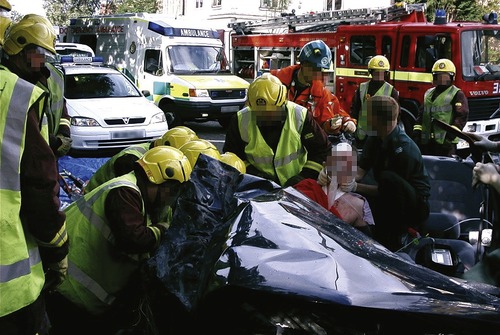CASE 3
 |
Incident
A car has collided with a bus 30 minutes ago at an estimated combined speed of 80 km/h (53 mph). The driver of the car is trapped and combative.
Relevant information
▪ Aircraft: Rotary wing
▪ Ground resources: One land ambulance. One ambulance response vehicle. Fire & Rescue and Police Services
▪ Retrieval options: General hospital 15 minutes by road. Major trauma hospital 30 minutes by air
▪ Other: Ambient conditions: Clear 12°C (54°F)
Questions
3.1 Summarise your pre-hospital plan.
On scene, the lead paramedic hands over the following clinical information:
3.2 Assuming the scene is safe, who do you approach first and why?
3.3 Explain the terms relative and actual entrapment.
Discussion
3.1 A pre-hospital plan is a continuously evolving mental plan of action that the PHR team will make as soon as they are activated, using the information given by the tasking agency. In many cases, this initial information is vague or incomplete, which reflects the problems experienced when receiving early phone calls about an incident. Although making a plan prior to arrival with limited information has drawbacks, there are clear benefits in arriving at the incident with a strategy for scene and patient management already in place. The plan often develops as the team travels to the scene and therefore valuable time en route should not be wasted.
When at the scene, the PHR team must have the skill to listen to all members of the emergency services and weigh up their suggestions as part of the overall plan. This may be difficult in the noisy, high-pressure environment of the pre-hospital arena. However, the PHR team has overall clinical responsibility for the patient and, as such, key medical decisions should go through them.
A generic pre-hospital plan could be:
The scene
• A safe approach (self, team, scene and others).
< div class='tao-gold-member'>
Only gold members can continue reading. Log In or Register to continue
Stay updated, free articles. Join our Telegram channel

Full access? Get Clinical Tree








